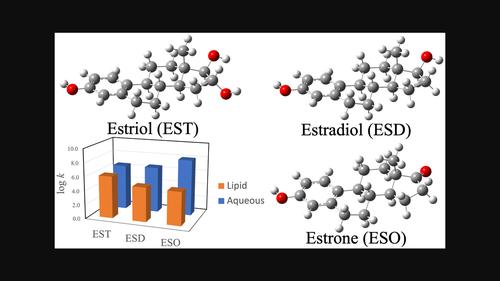当前位置:
X-MOL 学术
›
J. Phys. Org. Chem.
›
论文详情
Our official English website, www.x-mol.net, welcomes your
feedback! (Note: you will need to create a separate account there.)
On the hydroperoxyl radical scavenging activity of estrogens in lipid and aqueous media: A theoretical study
Journal of Physical Organic Chemistry ( IF 1.9 ) Pub Date : 2023-05-18 , DOI: 10.1002/poc.4545 María F. Hernández‐Hernández 1 , Eduardo A. Tejeda‐Medina 2 , César Espinoza , Manuel E. Medina 3
Journal of Physical Organic Chemistry ( IF 1.9 ) Pub Date : 2023-05-18 , DOI: 10.1002/poc.4545 María F. Hernández‐Hernández 1 , Eduardo A. Tejeda‐Medina 2 , César Espinoza , Manuel E. Medina 3
Affiliation

|
Despite the evidence on the antioxidant capability of estrogens, little is known about their reaction mechanism involved. According to the above, this work was carried out on the hydroperoxyl radical scavenging activity of three estrogens—estriol (EST), estradiol (ESD), and estrone (ESO)—in lipid and aqueous media by theoretical methodologies employing the DFT. In lipid and aqueous media, hydrogen transfer was the main reaction mechanism on the hydroperoxyl radical scavenging of EST, ESD, and ESO. The reaction rate constants calculated in lipid media were 1.08 × 106, 8.39 × 104, and 6.43 × 104 M−1 s−1 for the EST, ESD, and ESO, respectively. The reaction rate constants calculated in aqueous media were 3.00 × 106, 3.58 × 106, and 1.05 × 108 M−1 s−1 on the hydroperoxyl radical scavenging activity of EST, ESD, and ESO, respectively. The results also showed that the EST, ESD, and ESO estrogens could scavenge high reactivity radicals through the SET mechanism in aqueous media. In lipid media, estrogens are moderate antioxidants, whereas in aqueous media, these are good antioxidants. These theoretical results support the intrinsic antioxidant activity of EST, ESD, and ESO estrogens in lipid and aqueous media.
中文翻译:

脂质和水介质中雌激素的氢过氧自由基清除活性的理论研究
尽管有证据表明雌激素具有抗氧化能力,但对其所涉及的反应机制却知之甚少。根据上述内容,本工作通过采用密度泛函理论的理论方法,研究了三种雌激素——雌三醇(EST)、雌二醇(ESD)和雌酮(ESO)——在脂质和水介质中的氢过氧自由基清除活性。在脂质和水介质中,氢转移是EST、ESD和ESO清除氢过氧自由基的主要反应机制。在脂质介质中计算的反应速率常数为1.08 × 10 6、8.39 × 10 4和6.43 × 10 4 M -1 s -1分别为 EST、ESD 和 ESO。在水介质中计算的EST、ESD和ESO的氢过氧自由基清除活性的反应速率常数分别为3.00×10 6、3.58×10 6和1.05×10 8 M -1 s -1 。结果还表明,EST、ESD 和 ESO 雌激素可以通过水介质中的 SET 机制清除高反应性自由基。在脂质介质中,雌激素是中等抗氧化剂,而在水介质中,它们是良好的抗氧化剂。这些理论结果支持 EST、ESD 和 ESO 雌激素在脂质和水介质中的内在抗氧化活性。
更新日期:2023-05-18
中文翻译:

脂质和水介质中雌激素的氢过氧自由基清除活性的理论研究
尽管有证据表明雌激素具有抗氧化能力,但对其所涉及的反应机制却知之甚少。根据上述内容,本工作通过采用密度泛函理论的理论方法,研究了三种雌激素——雌三醇(EST)、雌二醇(ESD)和雌酮(ESO)——在脂质和水介质中的氢过氧自由基清除活性。在脂质和水介质中,氢转移是EST、ESD和ESO清除氢过氧自由基的主要反应机制。在脂质介质中计算的反应速率常数为1.08 × 10 6、8.39 × 10 4和6.43 × 10 4 M -1 s -1分别为 EST、ESD 和 ESO。在水介质中计算的EST、ESD和ESO的氢过氧自由基清除活性的反应速率常数分别为3.00×10 6、3.58×10 6和1.05×10 8 M -1 s -1 。结果还表明,EST、ESD 和 ESO 雌激素可以通过水介质中的 SET 机制清除高反应性自由基。在脂质介质中,雌激素是中等抗氧化剂,而在水介质中,它们是良好的抗氧化剂。这些理论结果支持 EST、ESD 和 ESO 雌激素在脂质和水介质中的内在抗氧化活性。

































 京公网安备 11010802027423号
京公网安备 11010802027423号